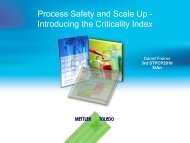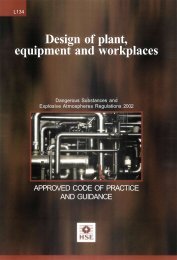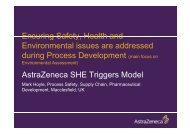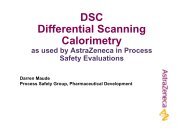Designing and operating safe chemical reaction processes HSG143
Designing and operating safe chemical reaction processes HSG143
Designing and operating safe chemical reaction processes HSG143
You also want an ePaper? Increase the reach of your titles
YUMPU automatically turns print PDFs into web optimized ePapers that Google loves.
Health <strong>and</strong> SafetyExecutiveRate of <strong>reaction</strong>: The rate at which conversion of reactants takes place.Reactants: Chemicals that are converted into products during the <strong>reaction</strong>process.Reaction: The process in which <strong>chemical</strong>s (reactants) are converted into other<strong>chemical</strong>s (products).Reaction calorimeter: A laboratory test apparatus for measuring thermal effectsof <strong>chemical</strong> <strong>reaction</strong>s or <strong>processes</strong>. For the purpose of this guidance, types of<strong>reaction</strong> calorimeters include isothermal, isoperibolic <strong>and</strong> adiabatic systems.Reactive systems screening tool (RSST TM ): A type of pseudo-adiabaticcalorimeter.Reasonably practicable: The degree of risk in a particular job or workplaceneeds to be balanced against the sacrifice in time, trouble, cost <strong>and</strong> physicaldifficulty of taking measures to avoid or reduce the risk. Measures must be takento eliminate or control the risks unless it is clear that the sacrifice incurred in doingso is grossly disproportionate to the level of the risk. However, the ability to payfor additional control measures is not a deciding factor as to whether they arenecessary.Reflux: A system condition in which a component in the <strong>reaction</strong> system(usually a solvent) is continually boiled off, condensed in a nearby condenser <strong>and</strong>subsequently returned to the <strong>reaction</strong> system.Relief system sizing: the sizing of an emergency relief vent.Relief system: All parts of the pressure-relief flow path from the protected vesselto atmosphere or containment within a disposal system. This includes reliefdevice(s), piping <strong>and</strong> any containment <strong>and</strong> disposal system.Risk: The chance of something adverse happening where ‘something’ refers toa particular consequence of the manifestation of a hazard. Risk reflects both thelikelihood that harm will occur <strong>and</strong> its severity in relation to the number of peoplewho might be affected, <strong>and</strong> the consequences to them.Risk assessment: The process of identifying the hazards present in anyundertaking (whether arising from work activities or other factors) <strong>and</strong> those likelyto be affected by them, <strong>and</strong> of evaluating the extent of the risks involved, bearing inmind whatever precautions are already being taken.RSST: see reactive systems screening tool.Runaway: A <strong>reaction</strong> that is out of control because the rate of heat generation byan exothermic <strong>chemical</strong> <strong>reaction</strong> exceeds the rate of cooling available.Semi-batch: An operation in which some materials are added to the reactor at thestart, with one or more other reactants added in a controlled manner during the<strong>reaction</strong>. See also semi-batch reactor.Semi-batch reactor: A type of reactor that is characterised by the supply, in acontrolled manner, of one or more key reactants during the <strong>reaction</strong>. Productsare only taken from the reactor upon conclusion of the <strong>reaction</strong> process.<strong>Designing</strong> <strong>and</strong> <strong>operating</strong> <strong>safe</strong> <strong>chemical</strong> <strong>reaction</strong> <strong>processes</strong> Page 63 of 64










